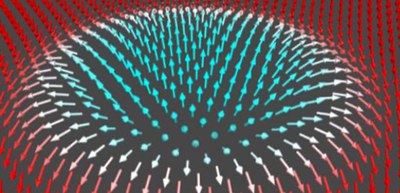
Skyrmion circuits with ultra-low energy consumption implemented
A group of researchers from Osaka University implemented a skyrmion Brownian circuit which can be operated at room temperature without supplying external energy.
To reduce power consumption for information processing devices, energy-saving computers are required. Molecules in a fluid constantly colliding with each other, which is attributed to Brownian motion, the random movement of suspended particles driven by thermal fluctuations of the solvent.
Small magnetic vortices called skyrmions behave as particles in a lattice of topologically stable knots in the spin structure. Since skyrmions can be driven by current, energy gradient, thermal fluctuations, they are expected to be used for magnetic memory and stochastic computing devices.
This group aims to use skyrimions for Brownian computing that exploits thermal motion of discrete signal carriers (tokens) for computations. Brownian motion is observed in particles in liquid, but when particle-like magnetic skyrmions, in which electrons spin in the opposite direction to those in the rest of the material, are used in a ferromagnetic film, Brownian motion is generated even in solid devices at room temperature. Thus, the implementation of a skyrmion Brownian circuit will allow for low-power applications.
The researchers implemented a skyrmion circuit in ferromagnetic magnetic thin film and observed that skyrmions moving in the circuit and at the junction without supplying external energy. They implemented a skyrmion Brownian circuit in a continuous ferromagnetic film with patterned SiO2 capping, which controls the saturation field of the ferromagnetic layer and forms a wire-shaped skyrmion potential well, which stabilizes skyrmion formation in the circuit.
Based on these achievements, this group is developing a device for a logical operation called “Conservative-join circuit (C-join)." To realize a skyrmion-based Brownian circuit, electrical control of skyrmion dynamics is required to construct components, such as Hub (for a token to move back and forth randomly due to thermal fluctuations), Ratchet (which restricts the direction of the token movement to one direction), and C-Join (which works as a signal synchronizer and has two input and two output wires).
Currently, the electric-current-based manipulation of skyrmions requires high power; however, if voltage control of skyrmion dynamics is realized in the future, this will allow for ultralow power Brownian computers.
Fabricating these circuits will be a basic technology for Brownian computers using skyrmions. It is anticipated that these technologies will enable the development of Brownian devices and new artificial intelligence (AI) hardware using Brownian logical operations.
Figure 1
Figure 2
Figure 3
Figure 4
Figure 5
The article, “Skyrmion Brownian circuit implemented in continuous ferromagnetic thin film,” was published in Applied Physics Letters at DOI: https://doi.org/10.1063/5.0011105.
